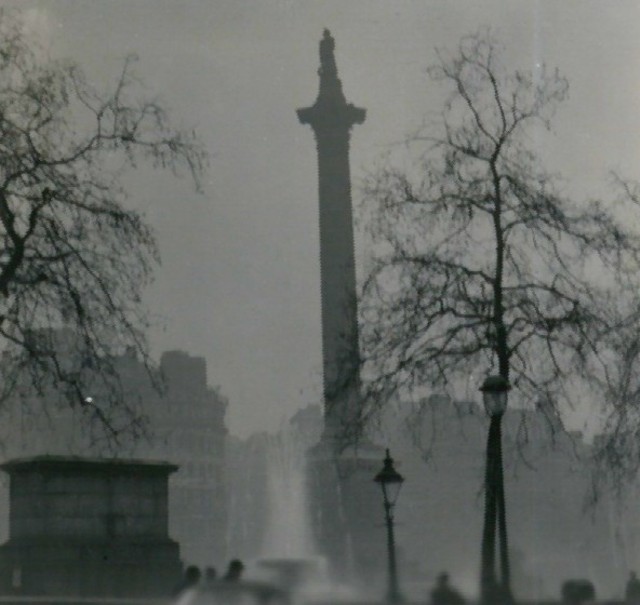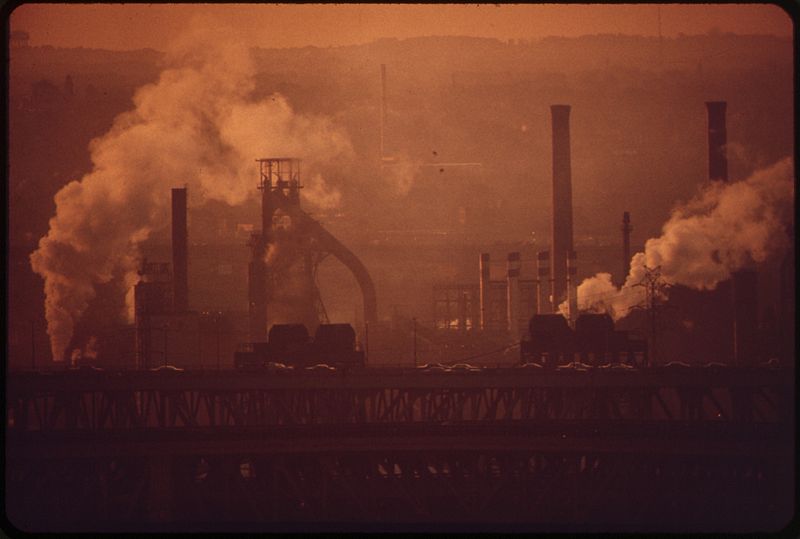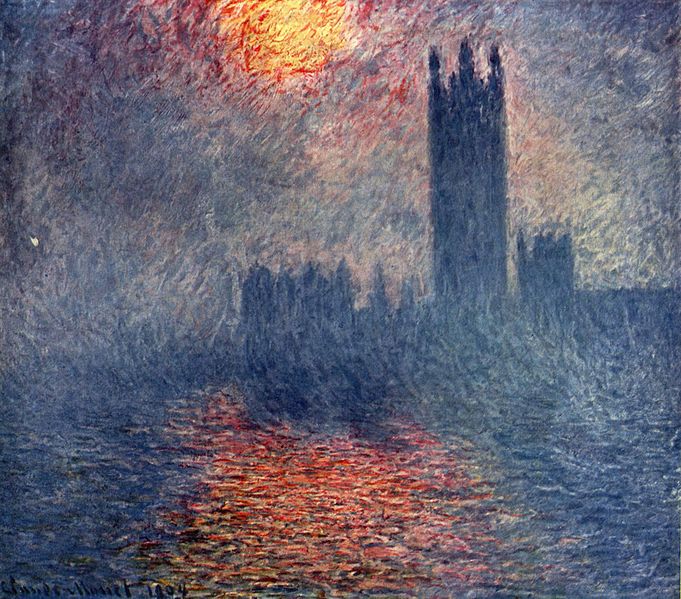The Ancient Romans had a goddess of sewers, named Venus Cloacina. Stercutius was the God of Dung.
Termite Trouble
During Hurricane Katrina, Formosan termites played a large role in the failure of flood walls in New Orleans. The seams of the walls were made from sugarcane waste, a favorite food of termites.
source: American Entomologist (Vol. 54, No. 3)
Londoners in the Soup
My past two blog posts have been about smoky cities in the U.S. Can you tell I’m obsessed? Today’s post will be about London fogs.
London used to be famous for its fogs. “Pea soupers,” they were affectionately called. Growing up, I spent many hours reading Sherlock Holmes, Bleak House, and A Little Princess, and watching spooky movies like Jekyll and Hyde and Jack the Ripper, so I pictured the city as dark and slightly ominous, swirling with fog. When I finally travelled to London in the early eighties, I was shocked by how bright it was.
In fact, heavy, dense fogs had been a fact of life for Londoners for decades. This article in The Times of London (5 December 1837) describes a particularly dismal day:
From daybreak yesterday morning the metropolis west and north-west of Charing-cross was enveloped in a fog the most dense remembered by the oldest person reading in that district. It commenced about 7 o’clock, and continued without any symptom of a clearance until 1 o’clock. Up to nearly 11 o’clock, not only was the darkness so great that the shops were all lighted up, but also every object in the streets, however near, was totally obscured from the view of the persons walking along. . . .It goes on to recount an incident where a coach crashed through a shop window, and how coaches and omnibuses had to have people leading the horses on foot through the streets.
An especially lethal fog rolled into London on December 5th, 1952. Similar to the inversion that had occurred in Donora in 1948 (which I blogged about on Friday), the dense air trapped smoke from the millions of coal fires close to ground level, so that people breathed air filled with tiny particles of sooty black coal. As the weather turned colder, people heaped more coal onto their fires.

London's Piccadilly 1952 © N T Stobbs and licensed for reuse under a Creative Commons Licence thanks to http://www.geograph.org.uk/photo/765606
People walked blindly, their arms outstretched so as not to bash into anything, unable to see their own feet. Theater and opera performances were cancelled because auditoriums filled with fog, making it impossible to see the performance. Crime sprees were reported around the city.
The wind finally blew away the fog, but not before killing thousands of people in four days. According to this article in the journal Environmental Health Perspectives, as many as 12,000 people may have died during or soon after the event.
This deadly environmental episode spawned public health research, the Clean Air Act of 1956, and new requirements that factories build taller chimneys.
Vexing Viking
In 986, a Viking named Bjarni Herjólfsson became the first European to spot North America. He was lost, trying to sail from Iceland to Greenland.
All Thumbs
Polar explorer Robert E. Peary discovered that the Inuits wore sealskin fur mittens with two thumbs. They could be swiveled around when the palms got wet.
A New Fleece on Life
Polybenzimidazole fiber, also known as Polarfleece, was invented in 1983 and made from recycled plastic soda bottles.
Happy Birthday
Charles Darwin and Abraham Lincoln were both born on this date, February 12th, 1809.
The Disaster You’ve Never Heard Of

SUNRISE IN STEEL MILL SMOKE, 07/1973 Frank J. Aleksandrowicz, National Archives ARC Identifier 550181
From time to time you read about industry lobbyists who pressure our government into easing some of the regulations on factories to reduce smog-causing chemicals. These regulations were put in place for very good reasons, and the idea that the government might loosen them should horrify you. As recently as 1948, before any clean air standards were in place, before there was an Environmental Protection Agency, people literally choked to death from polluted air. And even today, in countries without such legislation, people are dying from air pollution.
Do I sound shrill? I’ve been doing a lot of research into this. My next few blogs will be all about smoky cities.
Ask any grownup about the Donora Death Fog, one of the worst environmental disasters in American history, and chances are, you’ll be greeted with a blank look. And the crazy thing is, it happened so recently.
Donora, Pennsylvania is a small, hilly town in a narrow river valley about twenty miles south of Pittsburgh. In 1948 it had about 14,000 residents, 5,000 of whom worked at the many factories in town. Most of the factories were steel mills owned by U.S. Steel, but there was also a large zinc smelting pant. These factories produced a lot of smoke, dust and gas containing dangerous levels of sulphuric acid, carbon monoxide, and other pollutants.
A few days before Halloween, 1948, a weird atmospheric phenomenon known as an inversion occurred. An inversion is when a pocket of warm air traps the colder air near the ground. In Donora during that time, there was no wind, which meant that rather than blowing away, the smog became trapped, down where people lived and breathed. Inversions still happen all the time—Los Angeles has them frequently. But the one that trapped the smog around Donora for five days in October was especially deadly.
At first nobody paid much attention. Residents were used to smog. It made for beautiful sunsets, and it was a sign of industry and employment. Most people had no idea that it was bad for you, even though practically nothing green grew within a half mile of the zinc plant. As the deadly fog rolled in, kids walked to school with a flashlight. Cars had to drive with headlights on during the daytime. People reported that they couldn’t see their own feet. But it wasn’t long before people realized this smog was different. People started dropping dead. By Saturday, October 30th, seventeen people were dead in the space of twelve hours, and others were gasping for breath. Half the town’s population became sick or hospitalized with respiratory problems. The fire department went door to door, administering oxygen to people who were too sick to leave. Many people fled, but some who tried to evacuate were caught in the heavy traffic caused by the fog. The exact toll from the smog has never been accurately calculated, but at the time, twenty people died, and thousands more lived the rest of their lives with permanently damaged lungs.
It wasn’t until October 31st that the mills shut down operations as “a precaution,” and then it rained, which almost immediately helped disperse the pollutants. But the factory owners never admitted wrongdoing. The companies colluded with the U.S. Public Health Service to cover up the tragedy, calling it “an Act of God,” and the facts were kept hidden from the public for over fifty years. Vital records disappeared from the archives, and to this day, U.S Steel continues to block access to their records from the time of the incident.
Pittsburgh escaped the fog, primarily because it had just begun to enact smoke control ordinances—which you can read about in my next blog.
The tragedy marked a turning point in the government’s attitude toward regulating clean air. In 1955 the Clean Air Act was passed.
___________________
Source: Lynne Page Snyder, “The Death-Dealing Smog Over Donora, Pennsylvania,” Environmental History Review, Vol 18, No. 1 (Spring 1994) pp 117 – 139
Face Facts
Oliver Cromwell, the leader of the Protestant Reformation in England (1649), was the one who originally said “Paint me warts and all.”
Go Wide
Charles VIII of France (1470 – 1498) launched a new fashion for shoes with a square tip. He wore them to hide the fact that one of his feet had six toes.
